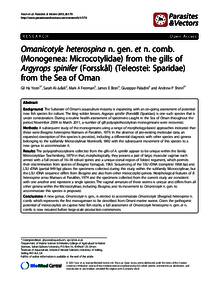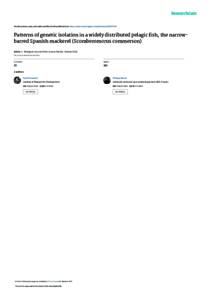وثيقة
Omanicotyle heterospina n. gen. et n. comb. (monogenea: microcotylidae) from the gills of argyrops spinifer (forsskål) (teleostei: sparidae) from the Sea of Oman.
المعرف
DOI: 10.1186/1756-3305-6-170
المساهمون
Al-Jufailiyah, Sarah., مؤلف
Freeman, Mark A., مؤلف
Bron, James E., مؤلف
Paladini, Giuseppe., مؤلف
Shinn, Andrew P., مؤلف
الناشر
BioMed Central.
ميلادي
2013-06
اللغة
الأنجليزية
الملخص الإنجليزي
Background: The Sultanate of Oman's aquaculture industry is expanding with an on-going assessment of potential new fish species for culture. The king soldier bream, Argyrops spinifer (Forsskål) (Sparidae), is one such species that is under consideration. During a routine health assessment of specimens caught in the Sea of Oman throughout the period November 2009 to March 2011, a number of gill polyopisthocotylean monogeneans were recovered. Methods. A subsequent study of the monogeneans using a range of morphology-based approaches indicated that these were Bivagina heterospina Mamaev et Parukhin, 1974. In the absence of pre-existing molecular data, an expanded description of this species is provided, including a differential diagnosis with other species and genera belonging to the subfamily Microcotylinae Monticelli, 1892 with the subsequent movement of this species to a new genus to accommodate it. Results: The polyopisthocotyleans collected from the gills of A. spinifer appear to be unique within the family Microcotylidae Taschenberg, 1879 in that, morphologically, they possess a pair of large, muscular vaginae each armed with a full crown of 16-18 robust spines and a unique dorsal region of folded tegument, which permits their discrimination from species of Bivagina Yamaguti, 1963. Sequencing of the SSU rDNA (complete 1968 bp) and LSU rDNA (partial 949 bp) places the specimens collected during this study within the subfamily Microcotylinae, but the LSU rDNA sequence differs from Bivagina and also from other microcotylid genera. Morphological features of B. heterospina sensu Mamaev et Parukhin, 1974 and the specimens collected from the current study are consistent with one another and represent a single species. The vaginal armature of these worms is unique and differs from all other genera within the Microcotylinae, including Bivagina, and its movement to Omanicotyle n. gen. to accommodate this species is proposed. Conclusions: A new genus, Omanicotyle n. gen., is erected to accommodate Omanicotyle [Bivagina] heterospina n. comb. which represents the first monogenean to be described from Omani marine waters. Given the pathogenic potential of microcotylids on captive held fish stocks, a full assessment of Omanicotyle heterospina n. gen. et n. comb. is now required before large-scale production commences.
المجموعة
ISSN
1756-3305
URL المصدر
قالب العنصر
مقالات الدوريات


